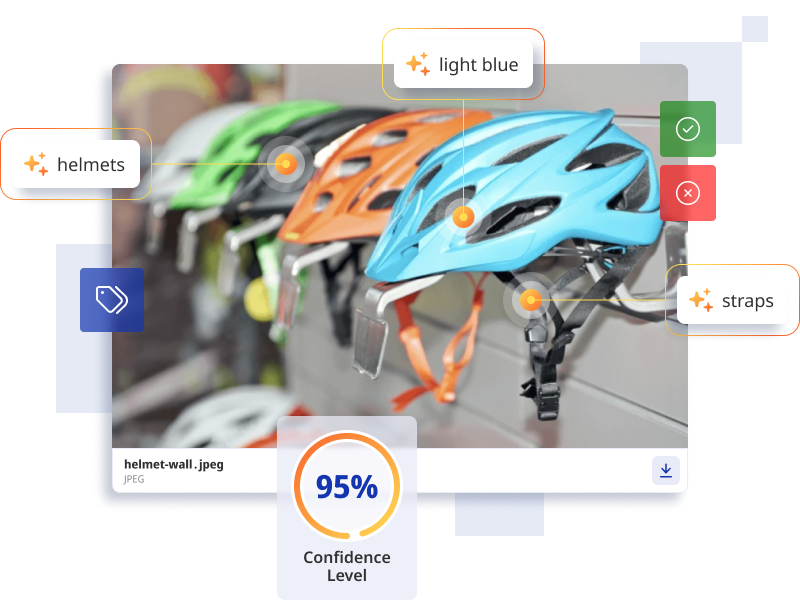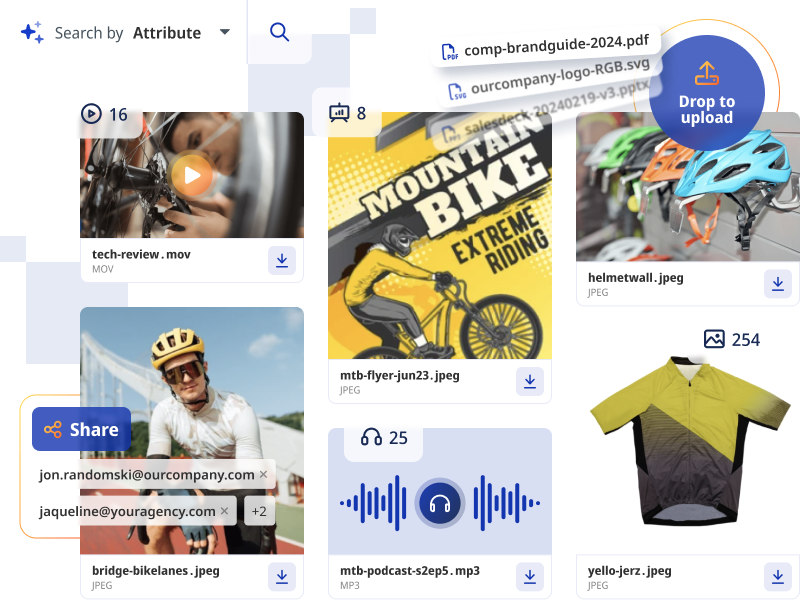How Brand Extensions Impact Business Growth—and Why Digital Asset Management is Essential
Expanding Your Brand Without Losing Your Identity
Every successful business reaches a point where it needs to grow—whether by launching new products, expanding into different markets, or partnering with other brands. This is where brand extensions come into play.

A brand extension allows companies to leverage their existing reputation to introduce new offerings. It’s a powerful strategy—when done right. But when a brand strays too far from its core identity, the extension can weaken the brand, confuse customers, and even hurt sales. This risk is known as brand dilution, where over-saturation and poor extension choices can erode the brand’s strength and identity.
So, How Do You Expand Your Brand The Right Way? And How Does Digital Asset Management (DAM) Help Companies Keep Their Branding Strong, Consistent, And Scalable?
Let’s Dive In.
What Is A Brand Extension? Brand Extension Examples
A Brand Extension Happens When A Company Introduces New Products, Services, Or Categories Under The Same Brand Name. Brand stretching is a strategic method used by established brands to introduce new products or enter new industries while leveraging their existing market reputation and customer loyalty. Instead Of Building A New Brand From Scratch, Businesses Can Use Their Current Credibility And Loyal Customer Base To Expand Faster.
A Great Example
Apple Went From Computers To iPhones, iPads, Apple Watches, And Apple TV+—All While Maintaining A Premium, Tech-Savvy Brand Identity.
A Bad Example
Colgate Once Launched A Frozen Dinner Line (Yes, Really). Customers Found It Bizarre—Because The Brand Is Associated With Toothpaste, Not Food. The Product Failed.
Lesson: A Brand Extension Should Feel Like A Natural Evolution—Not A Confusing Leap.
The Different Types Of Brand Extensions
1. Product Line Extension
Expanding an existing product line with new variations, also known as line extensions, can include new flavors, colors, or formulas.
Example: Coca-Cola introducing Coca-Cola Zero Sugar to appeal to health-conscious consumers.
2. Category Extension
- Expanding Into A Completely New Product Category While Staying True To The Brand’s Core Values.
- Example: Dyson Moving From Vacuum Cleaners To Hair Dryers, Using Its Expertise In Air Technology.
3. Co-Branded Extensions
- Partnering With Another Brand To Create A Limited-Edition, Cross-Industry Product.
- Example: Supreme And Louis Vuitton’s Streetwear-Luxury Collaboration Brought Exclusivity To Both Brands.
4. Digital Brand Extensions
- Expanding Into New Digital Offerings Like Apps, Subscription Services, Or E-Commerce.
- Example: Nike Launching Nike Run Club And Training Club Apps, Reinforcing Its Fitness-Driven Brand Identity.
5. Brand Lifestyle Extension
A brand lifestyle extension involves expanding a company’s product or service offerings to align with its brand’s values or distinct way of living. This type of extension aims to create a more comprehensive and immersive brand experience for consumers. By offering products that resonate with the brand’s core values and lifestyle, companies can create a deeper connection with their audience. This strategy not only enhances the overall brand image but also encourages consumers to fully embrace the brand’s lifestyle.
For example, outdoor apparel brand Patagonia has successfully implemented a brand lifestyle extension by offering environmentally-friendly clothing and gear that aligns with its values of sustainability and environmental responsibility. This extension has helped Patagonia build a loyal customer base that shares its values and is committed to reducing its environmental impact.
6. Complementary Product Extension
A complementary product extension involves creating new categories or a new line that works alongside the existing product. This type of extension can help companies recapture audiences already interested in the core brand and tempt new demographics to buy in. By offering complementary products, companies can increase their market share and revenue.
For instance, Apple’s introduction of the Apple Watch is a successful example of a complementary product extension. The Apple Watch works seamlessly with other Apple devices, such as iPhones and Macs, and offers a range of features that complement the existing product line. This extension has helped Apple expand its reach into the wearable technology market and increase its revenue.
7. Company Expertise Extension
A company expertise extension involves launching new products or services in an area in which the business doesn’t currently operate. This type of extension requires a strong established brand image and the ability to leverage customer trust. By utilizing its existing expertise and capabilities, companies can create new products or services that are related to their core offerings.
For example, Amazon’s launch of Amazon Web Services (AWS) is a successful example of a company expertise extension. AWS was born out of Amazon’s existing technology and capabilities, and has become a leading provider of cloud computing and infrastructure services. This extension has helped Amazon expand its reach into the technology industry and increase its revenue.
Benefits Of Brand Extensions
1. Increased Market Reach
Brand Extensions Can Significantly Expand A Company’s Market Reach By Tapping Into New Customer Demographics And Increasing Brand Awareness. By Leveraging The Existing Brand Equity Of An Established Brand, Companies Can Introduce New Products Or Services Without The Need To Build A New Brand From Scratch. This Approach Allows Businesses To Enter Unfamiliar Markets More Efficiently, Leading To Increased Sales, Revenue, And Market Share. For Instance, When A Well-Known Skincare Brand Launches A New Line Of Hair Care Products, It Can Attract Customers Who Trust The Brand’s Reputation For Quality, Thereby Broadening Its Customer Base And Market Presence.
2. Enhanced Brand Visibility
Brand Extensions Also Play A Crucial Role In Enhancing Brand Visibility. By Offering A Wider Range Of Products Or Services, Companies Can Create A Larger Shelf Presence, Which In Turn Boosts Brand Recognition And Customer Loyalty. When Customers See A Familiar Brand Name Across Different Product Categories, It Reinforces Their Trust And Encourages Them To Try New Offerings From The Same Brand. This Increased Visibility Not Only Strengthens The Brand’s Image But Also Drives Higher Market Share And Revenue. For Example, A Popular Beverage Brand Introducing A New Line Of Snacks Can Benefit From The Existing Customer Loyalty, Making It Easier To Gain Traction In The New Category.

The Risks Of Brand Extensions
Brand Confusion
If A New Product Doesn’t Align With Customer Expectations, It Can Weaken Trust And Credibility.
Branding Inconsistency
Expanding A Brand Requires New Marketing Assets, Visuals, And Campaigns—Which Can Easily Become Disorganized Or Off-Brand.
Content Chaos
Different Teams Use Different Assets, Different Versions Of The Logo, And Mixed Messaging Across Channels.
Slow Execution
A Messy Content Workflow Means Delays In Product Launches, Marketing Campaigns, And Brand Updates.
Solution
A Digital Asset Management (DAM) System Like ASMBL Helps Businesses Keep Branding On Track While Expanding Seamlessly.
Managing Brand Image and Reputation
When implementing a brand extension strategy, it’s essential to manage the brand image and reputation carefully. A successful brand extension can enhance the overall brand image and reputation, while a failed extension can damage it. To manage the brand image and reputation, companies should:
- Conduct market research to understand customer perceptions and needs
- Develop a clear and compelling brand message that aligns with the brand’s values and mission
- Create a unique and relevant product or service offering that resonates with the target audience
- Execute a well-planned marketing and promotion strategy that communicates the brand’s message and values
- Monitor and adapt to customer feedback and market trends to ensure the brand extension remains relevant and effective
By managing the brand image and reputation carefully, companies can minimize the risks associated with brand extensions and maximize the benefits.
Brand Extension Strategy
1. Define Clear Objectives
A Successful Brand Extension Strategy Begins With Defining Clear Objectives. Companies Need To Articulate What They Aim To Achieve With Their Brand Extension, Whether It’s Increasing Market Share, Expanding Into New Markets, Or Leveraging Existing Brand Equity. These Objectives Should Be Specific, Measurable, And Aligned With The Overall Business Strategy. By Setting Clear Goals, Businesses Can Ensure That Their Brand Extension Efforts Are Focused And Effective. For Instance, If A Company Aims To Enter The Health And Wellness Market, It Should Outline How The New Product Line Will Complement Its Core Brand And Meet The Needs Of Health-Conscious Consumers. This Clarity Helps In Making Informed Decisions And Executing A Successful Brand Extension Strategy.
How Digital Asset Management (DAM) Supports Brand Extensions
A Brand Extension Means Managing Thousands Of Marketing Assets—Logos, Images, Product Visuals, Videos, Campaign Materials, And More. Incorporating A Brand Lifestyle Extension Strategy, Companies Can Expand Their Offerings Beyond Their Original Expertise To Align With Their Brand Values And Enhance Customer Connection. Without A Centralized System, Teams Risk Using The Wrong Assets, Losing Control Of Branding, And Slowing Down Launches.
A DAM Platform Organizes, Stores, And Protects All Digital Assets, Ensuring Every Team Has The Right Content At The Right Time.
1. Ensures Brand Consistency
- A DAM Stores Logos, Fonts, Colors, And Approved Brand Assets In One Place.
- Teams Always Have Access To The Latest, Official Marketing Materials.
Without A DAM: Different Teams Use Outdated Logos, Inconsistent Messaging, And Mismatched Visuals.
With ASMBL DAM: Every Asset Is Branded, Approved, And Ready For Use.
2. Speeds Up Product Launches And Marketing Campaigns
- Automates Content Workflows So Teams Never Use Outdated Brand Materials.
- Organizes Assets By Product Line, Campaign, Or Region, Making It Easy To Scale.
Without A DAM: Teams Waste Time Searching For Scattered Assets.
With ASMBL DAM: Everything Is Organized, Searchable, And Accessible In Seconds.
3. Streamlines Global Brand Expansion
- Helps Brands Scale Internationally With Region-Specific Marketing Assets.
- Enables Quick Content Distribution Across Websites, Social Media, And Global Markets.
- Allows Remote Teams And Agencies To Collaborate Seamlessly.
Example: A Brand Launching In Multiple Countries Can Easily Localize Content While Maintaining Consistency.
4. Protects Brand Equity With Controlled Access
- Ensures Only Approved Visuals And Messaging Are Used Across Platforms.
- Prevents Off-Brand Content From Being Distributed.
- Tracks Who Is Using Assets And How They Are Being Shared.
Without A DAM: Teams Might Accidentally Use Outdated, Unapproved Assets.
With ASMBL DAM: Brand Managers Have Complete Control Over Brand Integrity.
Best Practices For Brand Extensions With DAM
1. Create A Brand Extension Style Guide
- Define Messaging, Visuals, And Content Rules For The New Product Or Service.
- Store And Share This Guide In Your DAM So All Teams Stay Aligned.
2. Organize Assets With Metadata & Smart Tagging
- Use AI-Powered Tagging To Categorize Assets By Campaign, Region, Or Audience.
- Make It Easy For Teams To Find The Exact Files They Need—Instantly.
3. Control Access And Permissions
- Restrict Access To Sensitive, Unreleased Content.
- Ensure Only Approved Stakeholders Can Edit, Share, Or Download Assets.
4. Track Asset Performance And Optimize Branding
- Monitor Which Assets Are Most Used In Brand Extension Campaigns.
- Use Insights To Refine Branding, Messaging, And Creative Strategies.
Why ASMBL Is The Best DAM For Brand Extensions
If Your Parent Brand Is Expanding Into New Products, Categories, Or Markets, ASMBL Provides The Ultimate Solution For Managing Brand Assets Efficiently.
What Sets ASMBL Apart?
- AI-Powered Search & Tagging – Instantly Find Assets For Brand Extensions
- Version Control & Approvals – Ensure Only The Latest, Brand-Compliant Content Is Used
- Secure Access Controls – Prevent Unauthorized Asset Usage
- Automated Workflows – Streamline Content Creation And Campaign Execution
With ASMBL’s DAM, Brands Can Launch New Products Faster, Maintain Brand Consistency, And Scale Effortlessly.
The Future Of Brand Extensions: Why Brands Must Act Now
Brand Extensions Offer Huge Opportunities—But Only If Managed Properly. Businesses That Fail To Maintain Brand Consistency Risk Confusing Customers And Weakening Their Reputation. Successful Brand Extensions Are Noteworthy Strategies That Can Expand Market Reach And Consumer Base, But They Require A Deep Understanding Of Consumer Needs And A Well-Planned Execution To Achieve Success.
A DAM System Ensures That Brand Messaging, Visuals, And Content Stay Aligned—Protecting Customer Trust And Brand Equity.
If Your Brand Is Expanding But Struggling With Content Management, It’s Time To Upgrade.
Discover How ASMBL’s DAM Helps Businesses Centralize, Manage, And Protect Their Brand Assets.


